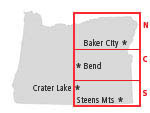







 |
 |
 |
 |
 |
 |
 |
 |

|
It's a Bird, It's a Plane — No, It is a
Bird
There are seven of us in the van. Assorted and the same, some
of us have known each other for more than thirty years; some
of us are strangers. We are male and female, spread in age from
fifty-somethings to those in their young twenties, a mix disparate
and similar. Whatever our background or differences, we are a
team with a common goal: to count as many birds as we can. Because I live in rural Clackamas County, I have, in the very
recesses of my mind, qualms about traveling with this group.
I frequently hear the disgruntled grumblings about the city and
the arm of Metro. I hear the fear, the uneasiness, the myths,
the resentment toward city folk as though urbanites carry an
infectious disease, certain to cripple livelihoods and morals.
And here we are, the heinous criminal element: a bunch of weirdo
bird-nuts from the city. I ignore my uneasiness. I’m willing
to be sneered at, ridiculed, and talked about as we stop frequently
to gawk, binocular-laden, gazing skyward, because what scoffers
do not know is how much fun this is. As we stop near Corvallis in pursuit of white woodpeckers, we soon learn that we are lucky to be in our van. The rule is that at least two people must identify a bird for the count — either hearing or seeing. Houck tries to make certain we all confirm our count, but some teams are hustled back into their vans as soon as two, usually their leaders, concur, an unnerving experience for the rest. (“Kingfisher.” “Yep.” Whoosh, everybody back in the van.) Some even use boom boxes with recorded birdcalls to lure the birds in; we have Houck. When he calls, they appear. We stop for dinner at a steakhouse in Burns where the waitress flirts with the guys and asks if any of them are doctors. Alarmed, we ask if she is OK. She reveals that she is looking for a doctor who will miraculously change her life and swoop her out of town. We offer that she can come birding with us, but she gives a disdainful look. I guess we’re a pathetic answer to her prayers. After dinner, we forge through the high desert in the moonlight to Malhuer, where we stay overnight at the field station in the dorms, a former job corps site, run by the government. Meals are taken in a common mess hall that is shared with other groups, but we’ve already had dinner and will leave too early for breakfast. At daybreak, we hit the road again, cruising along canals and ditches. We see what have become some of my favorite waterfowl in the dawn light — cinnamon teals, ruddy ducks, stilts (those red legs!) and avocets. By the time we arrive in the tiny town of French Glen, we are famished and decide to have breakfast at the old hotel, the news of which soon spreads lightning-like to the other groups, and for which we take ample ridiculing. We may have taken the time for all of us to identify our count,
and we may have had bacon, eggs, hash browns, pancakes and strawberry
waffles at the French Glen Hotel, but we are no slackers. We
have 194 species, second by only a few to one of the frantic
crews. And I am not ashamed to happily have invaded the rest
of the state as one of those weirdo bird nuts. |